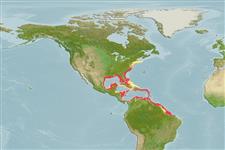>
Eupercaria/misc (Various families in series Eupercaria) >
Lutjanidae (Snappers) > Lutjaninae
Etymology: Lutjanus: Malay, ikan lutjan, name of a fish.
More on author: Poey.
Environment: milieu / climate zone / depth range / distribution range
Ecología
marino asociado a arrecife; rango de profundidad 10 - 190 m (Ref. 55), usually 30 - 130 m (Ref. 55). Subtropical; 43°N - 4°S, 100°W - 40°W (Ref. 55228)
Western Atlantic: Gulf of Mexico and eastern coast of the USA extending northward to Massachusetts, coasts of Florida (Ref. 26938), but rare north of the Carolinas. Throughout Gulf of Mexico (Ref. 26938). This species has been referred to as Lutjanus aya by previous authors, but Rivas (Ref. 6409) proved that Bodianus aya Bloch, 1790 is not a lutjanid, but probably a sciaenid.
Length at first maturity / Tamaño / Peso / Age
Maturity: Lm 39.3, range 25 - 47.5 cm
Max length : 100.0 cm TL macho / no sexado; (Ref. 26938); common length : 60.0 cm TL macho / no sexado; (Ref. 55); peso máximo publicado: 22.8 kg (Ref. 40637); edad máxima reportada: 57 años (Ref. 48779)
Espinas dorsales (total): 10; Radios blandos dorsales (total): 14; Espinas anales 3; Radios blandos anales: 8 - 9. Scale rows on back rising obliquely above lateral line. Specimens under 30 to 35 cm with large dark spot on the upper sides, located below the anterior soft dorsal rays.
Adults are found over rocky bottoms. Juveniles inhabit shallow waters, common over sand or muddy bottoms. Feed mainly on fishes, shrimps, crabs, worms, cephalopods, and some planktonic items including urochordates and gastropods. Marketed fresh and eaten steamed, broiled and baked (Ref. 9988). Heavily exploited in American waters where it is now closely protected; shrimp fishing, accused of destroying young snappers, is currently restricted.
Allen, G.R., 1985. FAO Species Catalogue. Vol. 6. Snappers of the world. An annotated and illustrated catalogue of lutjanid species known to date. FAO Fish. Synop. 125(6):208 p. Rome: FAO. (Ref. 55)
IUCN Red List Status (Ref. 130435)
Threat to humans
Reports of ciguatera poisoning (Ref. 30303)
Human uses
Pesquerías: comercial; pesca deportiva: si
Herramientas
Special reports
Download XML
Fuentes de Internet
Estimates based on models
Preferred temperature (Ref.
123201): 19.7 - 27.5, mean 24.4 °C (based on 218 cells).
Phylogenetic diversity index (Ref.
82804): PD
50 = 0.5000 [Uniqueness, from 0.5 = low to 2.0 = high].
Bayesian length-weight: a=0.01445 (0.01280 - 0.01632), b=2.97 (2.95 - 2.99), in cm total length, based on LWR estimates for this species (Ref.
93245).
Nivel trófico (Ref.
69278): 3.9 ±0.72 se; based on food items.
Generation time: 6.9 (6.1 - 7.8) years. Estimated as median ln(3)/K based on 19
growth studies.
Resiliencia (Ref.
120179): Medio, población duplicada en un tiempo mínimo de 1.4-4.4 años (K=0.12-0.2; tmax=16; Fec > 1 million).
Prior r = 0.48, 95% CL = 0.28 - 0.81, Based on 2 stock assessments.
Fishing Vulnerability (Ref.
59153): Moderate to high vulnerability (54 of 100).
Climate Vulnerability (Ref.
125649): Moderate to high vulnerability (51 of 100).
Nutrients (Ref.
124155): Calcium = 13.4 [7.2, 20.3] mg/100g; Iron = 0.274 [0.163, 0.455] mg/100g; Protein = 19.2 [17.8, 20.6] %; Omega3 = 0.195 [0.122, 0.314] g/100g; Selenium = 42 [23, 74] μg/100g; VitaminA = 59 [11, 265] μg/100g; Zinc = 0.245 [0.180, 0.365] mg/100g (wet weight);
